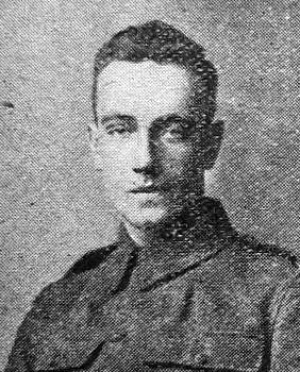
William Chappell was born on the 20th October 1895 in Batley, the son of Arthur and Hannah Maria Chappell, who were both born in Ossett. William Chappell was baptised at Ossett Holy Trinity church on the 15th January 1902, when he was aged six years. The Chappells lived at 6, Groudle Place, Broadowler Lane, Ossett, with William (known as “Willie”), his brother Joe (born 1894), sister Mary (born 1905), and his cousin Bertram Allsopp (born 1891), who was the adopted son of the Chappells.
By 1911, the Chappell household also includes Arthur’s mother Mary Chappell, 75. Ossett was principally a cloth making town, but also employed many in the local coal miners around Wakefield. Arthur Chappell was a stationary engineer and had married Hannah Maria (nee Green) in July 1892. Willie’s brother, Joe, was an apprentice blacksmith, and Bertram was a mill worker (rag maker), whilst Willie and his sister Mary were at school in 1911.
Willie joined the Church Lads Brigade in 1909, and the boys were disciplined locally in rifle drills and various military style exercises. In 1911 the small movement became recognised by the War Office as part of the Territorial Cadet Force and when the call to arms came in the summer of 1914, they formed the 16th (Service) Battalion (Church Lads Brigade) of the King’s Royal Rifle Corps (KRRC) under Field Marshal Lord Grenfell at Denham in Buckinghamshire. In early September 1914, Willie left his family and travelled first to London’s King Cross, and then to Denham. Willie writes to his mother as soon as he arrives in Denham, on a postcard he bought at the Swan Hotel on the Village Road:

Above: Willie Chappell’s postcard to his mother Hannah Chappell which was posted in 1914. The text reads as follows:
“Dear Mother, Arrived London 2pm. Came straight here. Can’t say where or what we shall do. This place Denham is near Webridge. Don’t worry shall be all right. Don’t know my address yet. Love from Willie.” He adds one more line: “Am in this hotel on the photo while writing”.
Mrs. Hannah Chappell sadly died herself in late 1918, aged 54, perhaps traumatised by the loss of her son?
Willie spent the next six months in Denham undertaking training and guard duties at local bridges and reservoirs, and two further months in Raleigh, Essex. In June 1915 the Lads moved to Clipstone Camp in Mansfield and were attached to the 100th Brigade in 33rd Division and that summer on to Perham Down, a village near Salisbury Plain, and Andover. Whilst at Clipstone, Willie’s service record states that on the 25th July 1915, he was “7 ½ hours late off leave” and he was fined one day’s pay as well as being confined to barracks for two days.
In November the Division received a warning order to prepare to sail for France, and the Brigade moved by train to Southampton with a total contingent of 30 officers and 994 other ranks, 64 horses and mules, 19 vehicles and 9 bicycles. Willie and the 16th Battalion (Church Lads Brigade) of the King’s Royal Rifle Corps ended their journey into war with a night Channel crossing and landed on 17th November in the Haute-Normandie region of France at Le Havre.
The following is an account from records of the KRRC 16th Battalion: From the Le Havre, the battalion moves first by train via Abbeville to Thienne on 19th November and then after a few days in Boesegham it marches on to Annezin by the 30th November. Various course and training continue while different parts of the battalion are giving some trench familiarisation in rotation. Others are attached to the 180th Tunnelling Company RE as working parties for mining activities. They move to St.Hilaire on the 12th December, where they remain until the 28th December. Christmas day 1915, passes without any special note and on the 28th/29th December they move to billets in Bethune. The Battalion gets the bath house on New Year’s day, but there is no clean kit available.
On 2nd January 1916, the first Sunday of the New Year, the battalion moves into the firing line for eight days in trenches near Bethune. The battalion’s position comes under an intense bombardment that lasts for hours. As the firing and shelling dies down, the damage has to be repaired. This work, together with digging out the buried men, goes for the next few days while the enemy continue to snipe, shell and machine gun. The battalion is relieved on the 10th of January.1 Their losses for that first Sunday alone were 9 killed and 27 wounded.
William Chappell’s service record shows that he was wounded in action on 28th January 1916 with gunshot wounds to the foot and head resulting in a fractured skull. He died of his wounds on the 31st January 1916 aged 20 years. William was 5’ 7½” tall and weighed 130 lbs. His complexion is recorded as sallow, with blue eyes and dark brown hair. His denomination was Church of England and the Army medics had certified him fit at Wakefield on the 21st September 1914.
William “Willie” Chappell is buried at Bethune Town Cemetery2 in the Pas de Calais area of France. Bethune Town Cemetery contains 3,004 Commonwealth burials of the First World War,11 being unidentified. This icludes 26 men of the 1/8th Manchester Regiment who were killed by a bomb on 22 December 1917 while marching to rest billets. Second World War burials number 19, two being unidentified. There are also 122 French and 87 German war graves, 38 of the German burials are unidentified.

Above: The Chappell grave at St. John’s Methodist Chapel showing the memorial to William Chappell, the son of Arthur Chappell. Picture courtesy of Lisa Jennings.

Commonwealth War Graves Commission Headstone (Photograph courtesy of Mark Smith)
References: